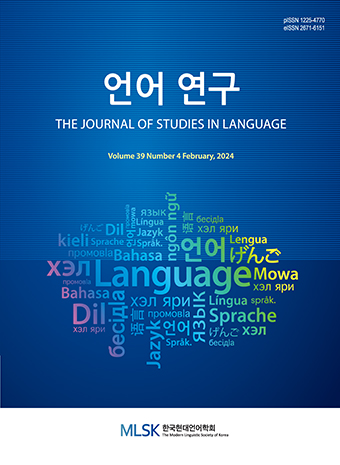Research Article
Abstract
References
Information
Employing qualitative analysis of online platforms and social media, this study explores the linguistic emergence of English and Korean neologisms during the COVID-19 pandemic’s ‘new normal’ era, identifying contemporary terms that encapsulate shifts in social dynamics and communication practices. It categorizes these neologisms into six themes: Adaptation and Response, Digital Transformation, Health and Well-being, Social and Cultural Shifts, Economic Reshaping, and Language Evolution. The research captures how the pandemic has globally impacted language, revealing shared experiences and universal themes amidst the crisis. It concludes by discussing the resilience and adaptability of language, highlighting the ongoing evolution of pandemic-era neologisms. The paper also delves into the methodological approach, emphasizing the importance of comparative analysis in understanding linguistic changes holistically. It underlines the significance of these neologisms in reflecting societal transitions, emphasizing their role in shaping future linguistic trends and communication strategies.
- Alhumaid, A. A. 2017. Language and Gender: a Socio-Cultural Feature Dominating Perception. International Journal of Humanities and Social Science 7.2.
- Birner, B. (ed.), 2020. Is English changing? Linguistic Society of America. Retrieved October 24, 2020, from https://www.linguisticsociety.org/content/english-changing.
- Cannon, G. 2012. A Linguistic Analysis of 4,520 New Meanings and New Words in English. Dictionaries: Journal of the Dictionary Society of North America, 97-109. 10.1353/dic.1982.0000
- Crystal, D. 2014. Words in Time and Place (ed.). Oxford: Oxford University Press.
- Eugene, A. N. 2012. Sociolinguistics as a Crucial Factor in Translating and Interpreting. Centro Virtual Cervantes, 43-50.
- Friedler, A. 2020. Sociocultural, behavioural and political factors shaping the COVID-19 pandemic: the need for a biocultural approach to understanding pandemics and (re)emerging pathogens. Global Public Health 16, 17-35. 10.1080/17441692.2020.1828982 33019889
- Harutyunyan, N. 2022. New Normal of Post-COVID and Post-Modern World in the Mirror of Language. American Folia Anglistika 18.2, 122-131. 10.46991/AFA/2022.18.2.122
- Harya, T. D. 2016. Language change and development: Historical linguistics. Premise. Journal of English Education 5.1, 103-117. 10.24127/pj.v5i1.418
- Ivanova, N. and Merkulova, N. 2021. New English Words for Describing the International English as a Current World Language Reality. Research in Language 19.1, 77-94. 10.18778/1731-7533.19.1.05
- Kim, E. K. 2022. A Study on the New Chinese and Korean Words Reflecting the Social Image of the New Normal Era. The Journal Of Humanities and Social Sciences 21 13.4, 1693-1706. 10.22143/HSS21.13.4.118
- Kriauciuniene, R. and Sangailaitė, V. 2016. An Inquiry into the Process of Lexical Expansion in Current English. Verbum 7, 127-143. 10.15388/Verb.2016.7.10291
- Lawson, R. 2020. Coronavirus has led to an explosion of new words and phrases - and that helps us cope in The Conversation, https://theconversation.com/coronavirus-has-led-to-an-explosion-of-new-words-and-phrases-and-that-helps-us-cope-136909.
- Lee, J., Park, H., and Song, S. 2022. Computational analysis of the language usage related to COVID-19 in Chousun-Ilbo and Hangyeore. Language Facts and Perspectives 56, 293-330.
- Liaojie. 2019. The Word Formation Characteristics of English New Vocabulary in the Internet Age. IOP Conference Series: Earth and Environmental Science 310.2, 1-5. 10.1088/1755-1315/310/2/022070
- Nabila, E. and Abdulrahman, T. R. 2021. An analysis of new English words created during COVID-19. Englisia: Journal of Language, Education, and Humanities 9.1, 19-32. 10.22373/ej.v9i1.9035
- Schmid, H. 2008. New Words in the Mind: Concept-formation and Entrenchment of Neologisms. Anglia 126.1, 1-36. 10.1515/angl.2008.002
- Song, C. S. 2016. Types and Characteristics of Modern Korean New Words(한국 근대 신어의 유형과 특성). Seoul: Yekrak.
- Strongman, L. 2017. Language evolution, acquisition, adaptation and change. In X. Jiang (ed.), Sociolinguistics: Interdisciplinary Perspectives. InTech 17-31. Retrieved from https://www.intechopen.com/books/sociolinguistics-interdisciplinary-perspectives/language-evolution-acquisition-adaptation-and-change. 10.5772/67767 28761650
- Wang, K. and Wu, H. 2017. Research on neologism detection in entity attribute knowledge acquisition. Proceedings of the 2017 5th International Conference on Machinery. Materials and Computing Technology 126, 690-693. 10.2991/icmmct-17.2017.142
- Williams, V., Boylan, A. M., and Nunan, D. 2020. Critical appraisal of qualitative research: Necessity, partialities and the issue of bias. BMJ Evidence-Based Medicine 25.1, 9-11. 10.1136/bmjebm-2018-111132 30862711
- Publisher :The Modern Linguistic Society of Korea
- Publisher(Ko) :한국현대언어학회
- Journal Title :The Journal of Studies in Language
- Journal Title(Ko) :언어연구
- Volume : 39
- No :4
- Pages :431-445
- DOI :https://doi.org/10.18627/jslg.39.4.202402.431




 The Journal of Studies in Language
The Journal of Studies in Language






